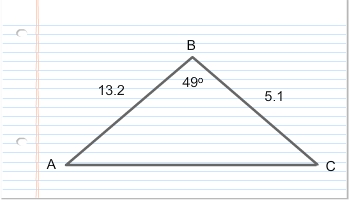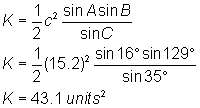Examples
When deciding which equation to use, look at the information you are given and decide which formula will work best.

Let’s go through some examples.
Example 1:
Find the area of  , given: a = 5.1, c = 13.2, and B = 49°.
, given: a = 5.1, c = 13.2, and B = 49°.
First, draw a diagram with the information that you have been given.

Given the information in this problem, use the equation:  .
.

Example 2:
Find the area of  , given: A = 16°, C = 35°, and c = 15.2.
, given: A = 16°, C = 35°, and c = 15.2.
First, draw a diagram with the information that you have been given.

Find the missing angle, Angle B:

Now you can find the area of the triangle.
